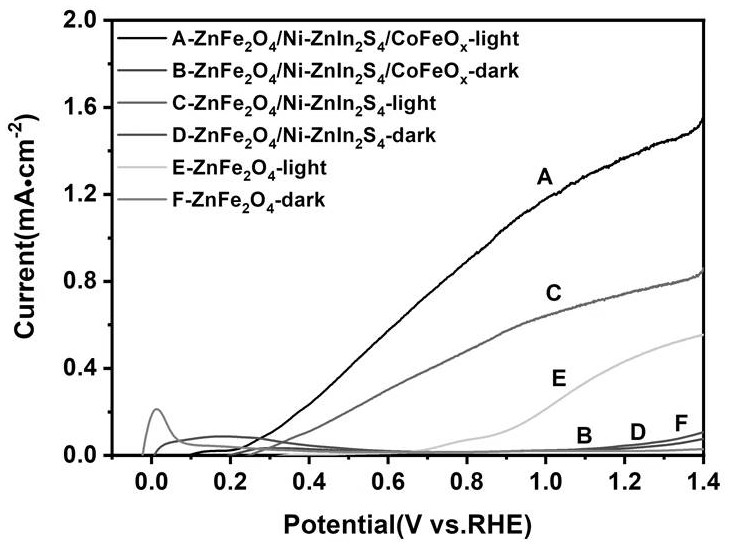Novel zinc ferrite and nickel doped zinc-indium-sulfur heterojunction photoelectrocatalytic anode material and preparation method thereof
A technology of photoelectric catalysis and anode materials, applied in chemical instruments and methods, physical/chemical process catalysts, chemical/physical processes, etc., can solve the problems of large overpotential and low catalytic efficiency, and achieve low cost and light corrosion resistance Excellent, excellent photoelectric performance
- Summary
- Abstract
- Description
- Claims
- Application Information
AI Technical Summary
Problems solved by technology
Method used
Image
Examples
Embodiment 1
[0048] Weigh 1 mole of sodium nitrate and 0.125 mole of ferric chloride hexahydrate, put them into a beaker and stir, and stir for 30 minutes to obtain a uniform hydrothermal reaction solution. The conductive glass or the deposition surface should be placed down, and the hydrothermal reaction solution The transfer volume needs to be checked not to be completely submerged in the conductive glass, and an unsubmerged part of 2 mm × 10 mm is reserved. The hydrothermal temperature should be set to 96 degrees Celsius, and the hydrothermal reaction time should be set to 3 to 4 hours. After taking out the conductive glass, rinse with ethanol and deionized water more than three times, and then vacuum dry at 60 degrees Celsius for 2 hours. Then, a drop-coating experiment was carried out on the iron oxyhydroxide substrate. The drop-coated zinc nitrate solution was 85 μl / cm 2 , and the volume ratio of ethanol and deionized water in the quantitative ratio solvent was 1:4, and then carried ...
Embodiment 2
[0050] Weigh 1 mole of sodium nitrate and 0.145 mole of ferric chloride hexahydrate, put them into a beaker and stir, and stir for 30 minutes to obtain a uniform hydrothermal reaction solution. The conductive glass or the deposition surface should be placed down, and the hydrothermal reaction solution The transfer volume needs to be checked not to be completely submerged in the conductive glass, and an unsubmerged part of 2 mm × 10 mm is reserved. The temperature of the hydrothermal should be set to 97 degrees Celsius and the time of the hydrothermal reaction should be set to 3 hours. After taking out the conductive glass, rinse with ethanol and deionized water more than three times, and then vacuum dry at 60 degrees Celsius for 2 hours. Then, a drop coating experiment was carried out on the iron oxyhydroxide substrate. The zinc nitrate solution for drop coating was 95 μl / cm 2 , and the volume ratio of ethanol and deionized water in the quantitative proportioning solvent was 1...
Embodiment 3
[0052]Weigh 1 mole of sodium nitrate and 0.17 mole of ferric chloride hexahydrate, put them into a beaker and stir, and stir for 30 minutes to obtain a uniform hydrothermal reaction solution. The conductive glass or the deposition surface should be placed down, and the hydrothermal reaction solution The transfer volume needs to be checked not to be completely submerged in the conductive glass, and an unsubmerged part of 2 mm × 10 mm is reserved. The temperature of the hydrothermal should be set to 98 degrees Celsius, and the time of the hydrothermal reaction should be set to 4 hours. After taking out the conductive glass, rinse with ethanol and deionized water more than three times, and then vacuum dry at 60 degrees Celsius for 2 hours. Then, a drop coating experiment was carried out on the iron oxyhydroxide substrate. The zinc nitrate solution for drop coating was 95 μl / cm 2 , and the volume ratio of ethanol and deionized water in the quantitative proportioning solvent was 1:...
PUM
 Login to View More
Login to View More Abstract
Description
Claims
Application Information
 Login to View More
Login to View More - R&D
- Intellectual Property
- Life Sciences
- Materials
- Tech Scout
- Unparalleled Data Quality
- Higher Quality Content
- 60% Fewer Hallucinations
Browse by: Latest US Patents, China's latest patents, Technical Efficacy Thesaurus, Application Domain, Technology Topic, Popular Technical Reports.
© 2025 PatSnap. All rights reserved.Legal|Privacy policy|Modern Slavery Act Transparency Statement|Sitemap|About US| Contact US: help@patsnap.com



